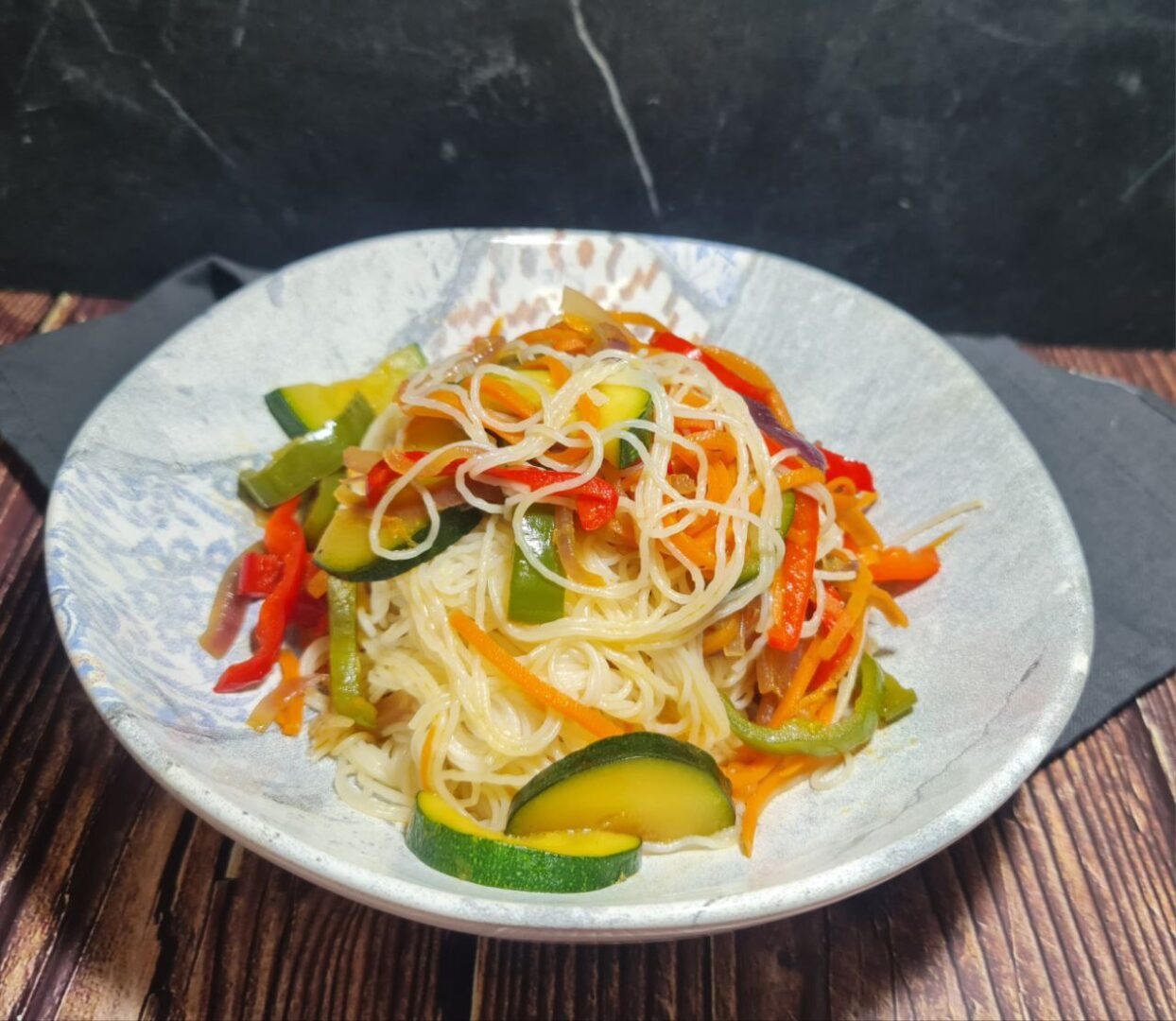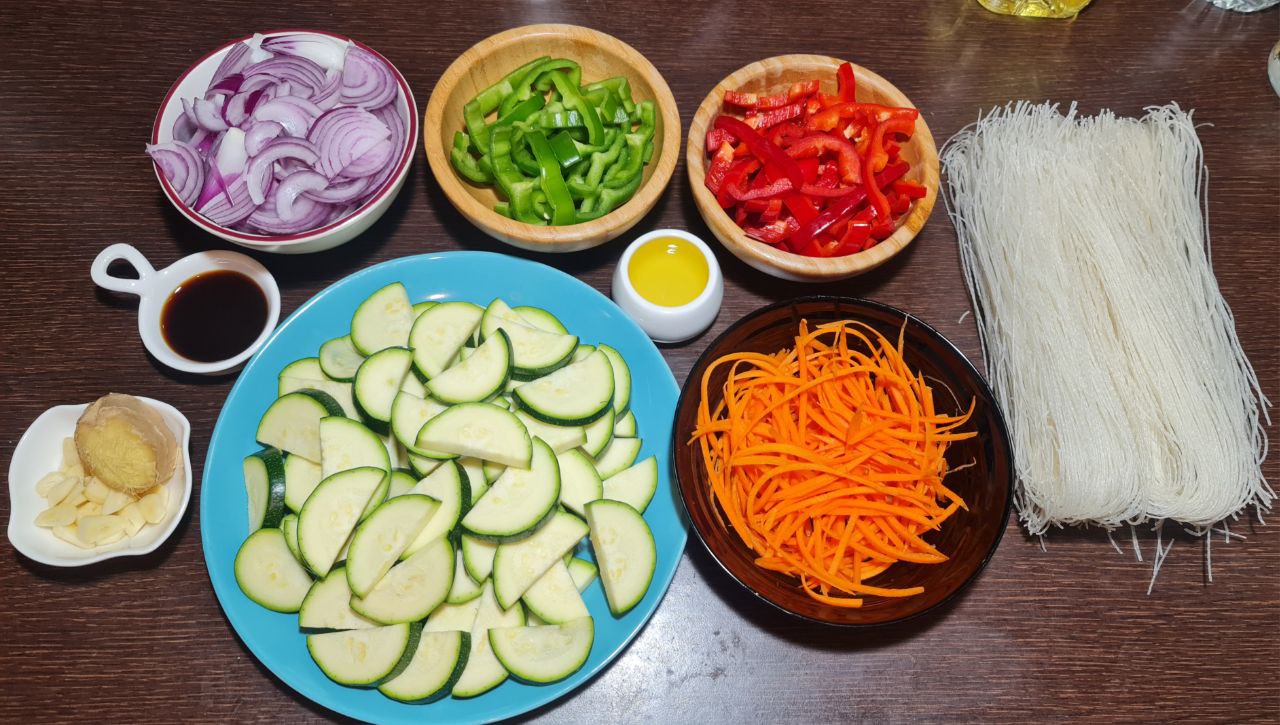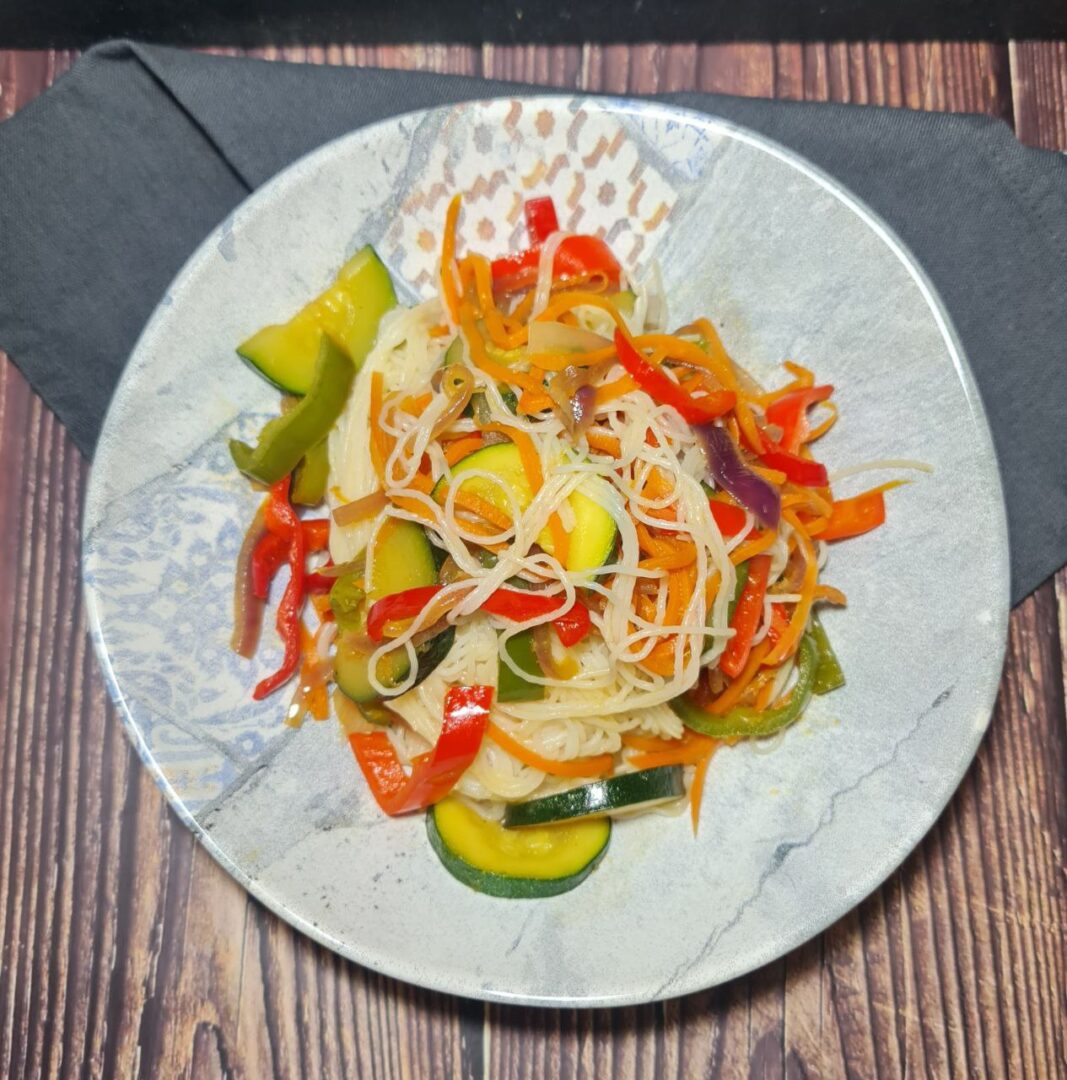Looking for a quick, healthy, and delicious meal option? Look no further than this mouthwatering recipe for rice noodles with vegetables. Packed with vibrant colors, fresh flavors, and wholesome ingredients, this dish is sure to become a staple in your recipe repertoire. Let’s dive in!

Rice noodles with vegetables offer a delightful combination of textures and flavors, making them a favorite among both veggie lovers and noodle enthusiasts. In this recipe, we’ll explore how to create a satisfying dish using simple ingredients that are easy to find in your local grocery store or pantry.
Rice Noodles with Vegetables Ingredient Notes
- Rice Noodles: Gluten-free and light, rice noodles provide a perfect base for absorbing the savory flavors of the dish while adding a satisfying chewiness.
- Bell Peppers, Red Onions, Carrot, Zucchini: These colorful vegetables not only enhance the visual appeal of the dish but also contribute a variety of vitamins, minerals, and antioxidants.
- Garlic and Fresh Ginger: Adding depth and warmth to the dish, garlic and ginger infuse the noodles and vegetables with aromatic goodness.
- Olive Oil and Soy Sauce: The dynamic duo of olive oil and soy sauce brings richness and umami flavor to the dish, tying all the ingredients together.
- Salt and Pepper: To taste, these simple seasonings elevate the flavors and ensure a perfectly balanced dish.

Tips for Making the Best Rice Noodles with Vegetables
- Prep Your Ingredients: Take the time to chop your vegetables uniformly to ensure even cooking. Additionally, soaking the rice noodles in warm water for about 10 minutes before cooking will help prevent them from sticking together.

- Don’t Overcook the Vegetables: Aim for crisp-tender vegetables to maintain their vibrant colors, textures, and nutrients. Overcooked vegetables can become mushy and lose their appeal.

- Season Thoughtfully: Taste as you go and adjust the seasonings according to your preference. Remember that soy sauce is salty, so be cautious when adding additional salt.
Recipe Variations (Vegan Delights)
- Protein Power – Boost the protein content of your dish by incorporating plant-based protein sources such as tofu, tempeh, or edamame. For a simple addition, cube firm tofu and pan-fry until golden brown before tossing with the noodles and vegetables. Marinating the tofu in a flavorful sauce beforehand adds an extra punch of flavor. Alternatively, try crumbling tempeh and stir-frying it with the vegetables for a hearty and satisfying dish. Edamame beans are another excellent option, adding a pop of color and texture to the dish while providing a complete source of plant-based protein.
- Spicy Sensations – Turn up the heat with spicy variations of rice noodles with vegetables. Add sliced chili peppers, such as Thai bird’s eye chili or serrano peppers, to the stir-fry for a fiery kick. For an extra layer of flavor, infuse the dish with chili garlic sauce or sriracha, adjusting the amount according to your desired level of spice. You can also incorporate spices such as crushed red pepper flakes or Chinese five-spice powder for a unique flavor profile. Don’t forget to balance the heat with a squeeze of lime juice or a sprinkle of fresh herbs to cool things down.
- Nutty Delights – Add a satisfying crunch and nutty flavor to your rice noodles with vegetables by incorporating toasted nuts or seeds. Sprinkle toasted sesame seeds or crushed peanuts over the finished dish for a burst of texture and flavor. You can also stir-fry cashews or almonds with the vegetables for a heartier and more indulgent meal. To enhance the nutty undertones, drizzle the dish with a splash of toasted sesame oil just before serving. Not only do nuts and seeds add a delightful crunch, but they also provide essential nutrients such as healthy fats, protein, and minerals.
- Creative Combos – Get creative with your rice noodles by experimenting with unique ingredient combinations. Consider adding shredded cabbage or kale for extra fiber and a pop of color. Mushrooms, such as shiitake or oyster mushrooms, lend a savory umami flavor that complements the dish beautifully. For a touch of sweetness, toss in sliced cherry tomatoes or pineapple chunks. You can also incorporate Asian-inspired ingredients like bamboo shoots, water chestnuts, or bean sprouts for added texture and complexity. Don’t be afraid to mix and match ingredients to create your own signature vegan masterpiece.
- Sauce Sensations – Customize the flavor profile of your rice noodles with vegetables by experimenting with different sauces and marinades. Swap out the soy sauce for tamari or coconut aminos for a gluten-free option. For a tangy twist, mix in a tablespoon of rice vinegar or lime juice to brighten up the flavors. You can also create a creamy sauce by combining coconut milk with curry paste or peanut butter for a rich and indulgent dish. Feel free to adjust the seasonings and spices to suit your taste preferences, and don’t hesitate to get creative with your sauce combinations.

Storage Suggestions: Keeping Your Rice Noodles with Vegetables Fresh
- Refrigeration – Store any leftover rice noodles with vegetables in an airtight container in the refrigerator to keep them fresh. Ensure that the noodles and vegetables are completely cooled before transferring them to the container to prevent condensation, which can make the dish soggy. Properly stored, rice noodles with vegetables will remain fresh in the refrigerator for up to three to four days.
- Reheating – When ready to enjoy your leftover rice noodles with vegetables, gently reheat them on the stovetop or in the microwave until heated through. If the noodles have absorbed some of the liquid and become dry, you can revive them by adding a splash of water or broth to loosen them up. Stirring occasionally while reheating will help distribute the heat evenly and prevent any hot spots.
- Freezing – While rice noodles with vegetables are best enjoyed fresh, you can freeze them for longer-term storage if needed. To freeze, portion the cooled noodles and vegetables into individual servings and place them in freezer-safe containers or resealable plastic bags. Press out any excess air before sealing to prevent freezer burn. Properly stored, rice noodles with vegetables will maintain their quality in the freezer for up to two to three months.
- Thawing – When ready to enjoy your frozen rice noodles with vegetables, transfer the desired portion from the freezer to the refrigerator to thaw overnight. Alternatively, you can thaw them more quickly by placing the sealed container or bag in a bowl of cold water. Once thawed, reheat the noodles following the same instructions as for refrigerated leftovers.
- Storage Considerations – To ensure the best quality and flavor, it’s important to properly label and date your stored rice noodles with vegetables. This will help you keep track of how long they’ve been in the refrigerator or freezer and ensure that you use them before they expire. Additionally, avoid storing the noodles with strongly flavored foods or ingredients, as they can absorb odors and flavors over time.
Frequently Asked Questions (FAQs): Rice Noodles with Vegetables
- Can I use other types of noodles for this recipe? – Absolutely! While rice noodles are the traditional choice for this dish, you can experiment with different types of noodles to suit your preferences. Popular alternatives include soba noodles, udon noodles, or even spaghetti noodles made from wheat or gluten-free grains. Just be mindful of cooking times and adjust accordingly.
- How can I prevent the noodles from sticking together? – To prevent the noodles from sticking together, be sure to follow the package instructions for cooking and rinsing. After draining the noodles, rinse them under cold water to remove excess starch and stop the cooking process. Toss them with a drizzle of oil to coat lightly and keep them separated until ready to use in the recipe.
- Can I make this dish ahead of time? – While rice noodles with vegetables are best enjoyed fresh, you can prepare certain components ahead of time to streamline the cooking process. Chop the vegetables and store them in an airtight container in the refrigerator for up to a day in advance. You can also prepare the sauce and store it separately until ready to use. Cook the noodles and stir-fry the vegetables just before serving to ensure optimal texture and flavor.
- How can I adjust the spice level of the dish? – To adjust the spice level of the dish, you can customize the amount and type of chili peppers or hot sauce used in the recipe. For a milder flavor, remove the seeds and membranes from the chili peppers before slicing them. Alternatively, you can omit the chili peppers altogether and offer hot sauce on the side for diners to add according to their preferences. Taste as you go and adjust the seasonings accordingly to achieve the desired level of heat.
- Can I make this dish gluten-free? – Yes, you can easily make this dish gluten-free by using gluten-free tamari or soy sauce instead of traditional soy sauce. Additionally, be sure to choose rice noodles that are certified gluten-free to accommodate any dietary restrictions or preferences. With these simple substitutions, you can enjoy a delicious gluten-free version of rice noodles with vegetables without sacrificing flavor or texture.
Rice Noodles with Vegetables Equipment
- Large pot for boiling noodles
- Wok or large skillet for stir-frying vegetables
- Cutting board and knife for chopping vegetables
- Cooking utensils: spatula, tongs, etc.
Rice noodles with vegetables offer a delightful blend of flavors, textures, and nutrients in every bite. Whether you’re craving a quick weeknight dinner or a nutritious meal to fuel your day, this recipe fits the bill perfectly. With simple ingredients, customizable variations, and easy preparation, it’s a winner for busy cooks and discerning palates alike. So, gather your ingredients, fire up the stove, and treat yourself to a satisfying bowl of homemade goodness. Enjoy!
More dinner ideas:
- Deliciously Easy Red Lentil Dahl
- Authentic Penne all’Arrabbiata Recipe Made Easy
- Baked Eggplants with Couscous

Rice Noodles with Vegetables
Indulge in a flavorful and wholesome meal with this quick and easy recipe for rice noodles with vegetables. Packed with vibrant colors, fresh ingredients, and aromatic flavors, this dish is perfect for busy weeknights or whenever you're craving a satisfying plant-based meal. Enjoy the delightful combination of tender rice noodles, crisp vegetables, and savory seasonings in every bite!
Ingredients
- 6.75 oz. (200g) rice noodles
- 2 bell peppers (any color), thinly sliced
- 2 red onions, thinly sliced
- 1 carrot, julienned
- 1 zucchini, thiny sliced
- 3 cloves of garlic, minced
- 2 tbsp olive oil
- 2 tbsp soy sauce (or tamari for gluten-free)
- 1 teaspoon fresh ginger, grated
- Salt and pepper to taste
- Optional garnishes: chopped cilantro, sliced green onions, lime wedges
Instructions
- Place the rice noodles in a large bowl and cover with hot water. Let them soak for about 8-10 minutes, or until they are tender but still slightly firm. Drain and set aside.
- Heat olive oil in a large skillet or wok over medium heat. Add the minced garlic and grated ginger, and sauté for about 1 minute, until fragrant.
- Add the sliced bell peppers, red onions, julienned carrot, and zucchini to the skillet. Stir-fry for 5-6 minutes, or until the vegetables are crisp-tender. Season with salt and pepper to taste.
- Add the soaked rice noodles to the skillet with the cooked vegetables. Pour the soy sauce over the noodles and vegetables, and toss everything together until well combined. Cook for an additional 2-3 minutes, allowing the flavors to meld.
- Divide the rice noodles with vegetables among serving bowls. Garnish with chopped cilantro, sliced green onions, and a squeeze of fresh lime juice, if desired. Serve hot and enjoy!
Notes
- Take the time to chop your vegetables uniformly and soak your rice noodles properly to ensure even cooking and texture throughout the dish.
- Taste and adjust the seasoning of the dish as you cook, keeping in mind that soy sauce adds saltiness. Be cautious with additional salt, and feel free to customize the flavor with extra soy sauce, fresh herbs, or a splash of lime juice.
- Keep an eye on the vegetables while stir-frying to ensure they remain crisp-tender. Overcooking can result in mushy vegetables, so aim for a vibrant and slightly crunchy texture for the best dining experience.


